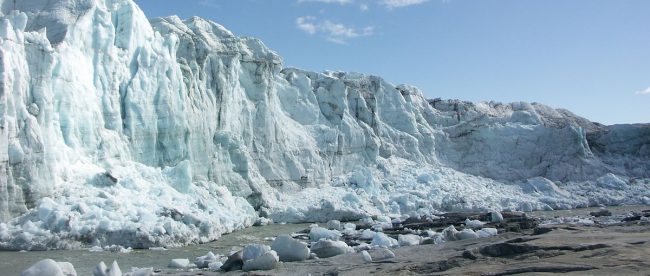When Ice Was a Hot Gift

Walk into just about any grocery store in America and you can buy a huge, 10-pound bag of ice for about $3. Most people have freezers and many have ice makers on their refrigerators, but if you’re having a party, it may be a good idea to invest in a big bag of ice, especially given the price. It’s a product of convenience, nothing more.
Unless it came from Greenland.
The big bags of ice you’ll buy for your 4th of July barbeque are typically made from regularly-accessible water and probably come from a local source. While a long time ago — in the days before ubiquitous refrigeration and freezing — there was a robust ice trade, one which involved capturing icebergs and chopping them up, those days were long past by the mid-1980s. And yet, for a brief moment in 1984, imported Greenland glacial was all the rage.
The idea to do such a thing came a year earlier when a television executive named William F. Baker traveled to the North Pole. An adventurer by nature — he had previously visited the South Pole — Baker wanted to share his experience with some people back home. So he brought back with him about 120 pounds of glacial ice, had it chipped up, and gave it to a bunch of people who would be impressed by chipped bags of imported glacial ice.
It was a hit, and some of his friends wanted to get in on the action. One thing led to another and by the spring of 1984, a new product, known as “Glazonice,” was exclusively available at Bloomingdale’s, the iconic Manhattan department store.
Glazonice was ice, but not any ice — it was formed perhaps as long ago as 100,000 years earlier and therefore, Bloomingdale’s claimed, was as pure (whatever that means) and clean as any ice you can get. Some believed that the ice melted slower and therefore didn’t dilute your drink as much, although there weren’t any meaningful scientific experiments to back up that belief. But the novelty was the major selling point anyway. The marketing team came up with a pretty good selling point for Glazonice, asking “’What’s more perfect for celebrating the birth of a child or a wedding than 12-year-old Scotch with 100,000-year-old ice?” At $7 for 35 ounces — that’s about $32 for ten pounds — it wasn’t unaffordable, either. (But that’s pretty pricey for ice.)
The product, perhaps surprisingly, proved popular. Some wanted to test the special ice for themselves; others thought it’d be a good gift; still, others just wanted to be part of the moment. Buyers came in from a few hours away to purchase the product — spending more on gas and tolls (or train tickets) than one would normally spend on ice — and it seemed that Bloomie’s had a winner on its hands.The AP reported (via Untapped Cities) that Bloomingdale’s sold sixty bags of luxury ice in the product’s first two days alone.
But the fad didn’t last — the product wasn’t offered during the 1985 spring shopping season. Since then, new parents and newlyweds everywhere have had to resort to regular old ice for their Scotch.
Bonus fact: Perhaps the only thing weirder than selling 100,000-year-old ice from Greenland is having to figure out the import tax on importing 100,000-year-old ice from Greenland. The New York Times reported that, when Baker brought back his first 120 pounds of ice, there was a debate over the levy: “At Kennedy International Airport the customs agents gave a cold shoulder [ha ha] to the suggestion that since the ice was more than 100 years old it should be regarded as antique and therefore allowed in duty free. It was, customs declared, food and thus subject to duty. Finally, however, they decided it was merely ice and duty-free at that.”
From the Archives: The Ice King Cometh: The man who made a fortune importing ice.
